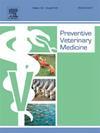The epidemiology of mast cell tumours in insured dogs in Sweden
IF 2.4
2区 农林科学
Q1 VETERINARY SCIENCES
引用次数: 0
Abstract
Background
Mast cell tumour (MCT) is the most common skin neoplasia in dogs. This study aimed to explore the incidence rate, cause-specific mortality rate and risk factors (breed, age, gender) for MCT in insured dogs in Sweden (2011–2016).
Results
The study population of this cohort study included just over 600,000 dogs, which either were insured for veterinary care, life, or both. There were 917 dogs with veterinary care claims for MCT, and the incidence rate was 5.23 (95 % confidence interval (CI): 4.90–5.58) cases per 10,000 dog-years at risk (DYAR). The risk of MCT was higher in females than in males (relative risk (RR) 1.29, 95 % CI: 1.13–1.48, P < 0.001). The breeds at highest risk were the Dogo Argentino (RR 30.0, 95 % CI 9.70–70.2) and Boxer (RR 9.78, 95 % CI 7.02–13.3), while the Jämthund (RR 0.10, 95 % CI 0.01–0.35) and Cavalier King Charles spaniel (RR 0.06, 95 % CI 0.00–0.35) had the lowest risk. The median age at first diagnosis was 7.93 (range 0.44–15.4) years. In total, 11.6 % of the affected dogs suffered multiple MCT events. The cause-specific mortality rate was 0.79 (95 % CI: 0.63–0.97) deaths per 10,000 DYAR, and 87 of all dogs that were covered by life insurance died of MCT-related causes at a median age of 8.33 years (range 2.16–11.7). The Shar-pei (RR 51.5, 95 % CI: 13.7–137.0) had the highest risk of MCT-related death.
Conclusions
MCT mainly affected middle-aged to older dogs, and large breed-related differences in the risk of MCT and MCT-related death were found.
瑞典保险犬肥大细胞肿瘤的流行病学研究
肥大细胞瘤(MCT)是犬中最常见的皮肤肿瘤。本研究旨在探讨2011-2016年瑞典投保犬MCT的发病率、原因特异性死亡率和危险因素(品种、年龄、性别)。结果这项队列研究的研究人群包括60多万只狗,它们要么有兽医护理保险,要么有人寿保险,要么两者兼而有之。有917只狗接受了MCT的兽医护理,发病率为5.23(95 %置信区间(CI): 4.90-5.58) / 10000狗年风险(DYAR)。女性患MCT的风险高于男性(相对危险度(RR) 1.29, 95 % CI: 1.13-1.48, P <; 0.001)。风险最高的品种是阿根廷杜高犬(RR 30.0, 95 % CI 9.70 ~ 70.2)和博克瑟犬(RR 9.78, 95 % CI 7.02 ~ 13.3),风险最低的品种是Jämthund (RR 0.10, 95 % CI 0.01 ~ 0.35)和骑士查尔斯王犬(RR 0.06, 95 % CI 0.00 ~ 0.35)。首次诊断的中位年龄为7.93岁(范围0.44-15.4岁)。总共有11.6% %的受影响的狗遭受了多重MCT事件。死因特异性死亡率为每10000年0.79例(95 % CI: 0.63-0.97)死亡,所有人寿保险覆盖的狗中有87例死于mct相关原因,中位年龄为8.33岁(范围2.16-11.7)。沙皮犬(RR 51.5, 95 % CI: 13.7-137.0) mct相关死亡风险最高。结论smct主要影响中老年犬,MCT发生风险及MCT相关死亡存在较大的品种相关性差异。
本文章由计算机程序翻译,如有差异,请以英文原文为准。
求助全文
约1分钟内获得全文
求助全文
来源期刊

Preventive veterinary medicine
农林科学-兽医学
CiteScore
5.60
自引率
7.70%
发文量
184
审稿时长
3 months
期刊介绍:
Preventive Veterinary Medicine is one of the leading international resources for scientific reports on animal health programs and preventive veterinary medicine. The journal follows the guidelines for standardizing and strengthening the reporting of biomedical research which are available from the CONSORT, MOOSE, PRISMA, REFLECT, STARD, and STROBE statements. The journal focuses on:
Epidemiology of health events relevant to domestic and wild animals;
Economic impacts of epidemic and endemic animal and zoonotic diseases;
Latest methods and approaches in veterinary epidemiology;
Disease and infection control or eradication measures;
The "One Health" concept and the relationships between veterinary medicine, human health, animal-production systems, and the environment;
Development of new techniques in surveillance systems and diagnosis;
Evaluation and control of diseases in animal populations.
 求助内容:
求助内容: 应助结果提醒方式:
应助结果提醒方式:


